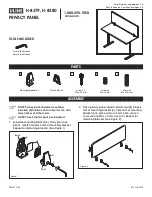
Performing Time Domain Measurements
Practical Considerations
Chapter 4
96
By increasing or decreasing the filter value above or below the default, a tradeoff can be made
between pulse width (rise time) and side-lobe level (dynamic range). The key is to pay
attention to the calculated frequency-domain response vs. the original data when changing
the value of the filter.
3. Aliasing
When data is first measured, a saved data file is first loaded, or the measurement frequencies
are changed, the time domain start- and stop-points are calculated to give the best fit possible
without aliasing. The start/stop window may be varied along the time base, but should not be
widened or aliasing will occur. This is because the Fourier transforms are taken at discrete
points, and the data is only valid over a finite range in the time domain.
For example, as shown in the figure below, the frequency step size has been increased, and the
aliasing that occurs with the larger step size is clearly visible in the time-domain response. In
general, the time window in which no aliasing will occur is equal to T=1/frequency step.
Summary of Contents for N4413A
Page 4: ...iv ...
Page 11: ...1 1 About the Multiport Test System ...
Page 18: ...About the Multiport Test System Available Options and Accessories Chapter 1 8 ...
Page 19: ...9 2 User Interface ...
Page 27: ...17 3 Using the Multiport Test System ...
Page 89: ...79 4 Performing Time Domain Measurements ...
Page 109: ...99 5 Menu Reference ...
Page 163: ...153 6 Maintenance and Troubleshooting ...
Page 172: ...Maintenance and Troubleshooting Contacting Agilent Chapter 6 162 ...
Page 173: ...163 7 Instrument Information ...
Page 208: ...Instrument Information Specifications and Characteristics Chapter 7 198 ...
Page 209: ...199 8 Safety and Regulatory Information ...
Page 218: ...Safety and Regulatory Information Regulatory Information Chapter 8 208 ...
Page 219: ...209 A Other Technical Procedures ...
Page 224: ...Other Technical Procedures IF Gain Adjustment Appendix A 214 ...
















































